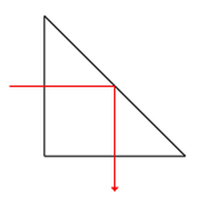-

-
Courses
Find courses by:
Collections
Cross-Disciplinary Topic Lists
- About
- Donate
- Featured Sites

 |
|
By the end of this lecture, you should:
› View/hide answer
 In the prism shown, about 4% of the light would be lost to reflection at the entry point of air to glass, and a similar amount at the exit surface. The total internal reflection will reflect 100% of the light in the plane perpendicular to the page, and slightly less in the plane parallel to the page. So overall there will be a bit less light than the 92% the aluminum would have given, and it will be slightly polarized. The final decision might rest on other factors like the glass surfaces of a prism being more resistant to abrasion than an aluminum layer is, or what manufacturing facilities are available.
In the prism shown, about 4% of the light would be lost to reflection at the entry point of air to glass, and a similar amount at the exit surface. The total internal reflection will reflect 100% of the light in the plane perpendicular to the page, and slightly less in the plane parallel to the page. So overall there will be a bit less light than the 92% the aluminum would have given, and it will be slightly polarized. The final decision might rest on other factors like the glass surfaces of a prism being more resistant to abrasion than an aluminum layer is, or what manufacturing facilities are available.
› View/hide answer
At the Brewster angle, 100% of the light polarized parallel to the glass will enter. It will enter the other wall of the glass at the glass-to-air Brewster angle, and again the parallel polarized light will pass 100%. By Snell’s Law, the same angles are involved in exiting, except for a sign, so the transmission of 85% (100% - 15%) of the perpendicularly polarized light applies each time for .852 = .7225 of it getting through. The light has 100% of the original parallel component and 72% of the original perpendicular component. In a gas laser, multiple passes through such plates rapidly results in 100% parallel polarization.
› View/hide answer
First we must use Snell's Law to find the refraction angle \({\theta _2}\). Since \({n_1}\sin {\theta _1} = {n_2}\sin {\theta _2}\), we have with the appropriate indices \[{\theta _2} = {\sin ^{ - 1}}\left( {\frac{{{n_1}\sin {\theta _1}}}{{{n_2}}}} \right) = {\sin ^{ - 1}}\left( {\frac{{1\sin 88^\circ }}{{1.33}}} \right) = 48.7^\circ \] basically the same result as for 90º incidence in the lecture. We can solve Fresnel’s equations for the amplitude ratios:\[{r_\parallel } = - \frac{{\tan ({\theta _1} - {\theta _2})}}{{\tan ({\theta _1} + {\theta _2})}} = - \frac{{\tan (88 - 48.7)}}{{\tan (88 + 48.7)}} = - \frac{{\tan (39.3)}}{{\tan (136.7)}} = \frac{{.81849}}{{.94235}} = .8686\]and \[{r_ \bot } = - \frac{{\sin ({\theta _1} - {\theta _2})}}{{\sin ({\theta _1} + {\theta _2})}} = - \frac{{\sin (39.3)}}{{\sin (136.7)}} = - \frac{{.63338}}{{.68582}} = .9235\] To get intensities we need to square these to find that the parallel light is 75% and the perpendicular light 85% the intensity of the incoming beam. The vertically oriented polarizer would cut the parallel component, or less than half of the incoming light. Polarizing sunglasses would be relatively ineffective at cutting this sort of glare. (With the Sun higher, near the Brewster angle, they would be very effective.)